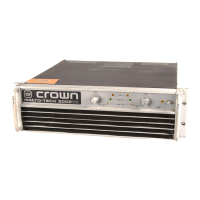
Do you have a question about the Crown Macro-Tech MA-5000VZ and is the answer not in the manual?
Covers warranty terms, exclusions, and what the warrantor will do for purchasers globally.
Details items not covered by the Crown warranty, such as misuse, accidents, or negligence.
Outlines how to obtain warranty service, including notification and shipping requirements.
States that Crown is not liable for incidental or consequential damages resulting from product defects.
Explains warranty limitations and Crown's right to modify designs without notice.
Specifies legal rights and time limits for enforcing warranty claims.
Summarizes Crown warranty terms for North American purchasers, excluding certain damages.
Lists items excluded from the North American warranty, including damage from misuse or accidents.
Details how to obtain warranty service in North America, including shipping and factory service.
Addresses consequential and incidental damages, noting state variations in exclusions.
Clarifies warranty modifications, time extensions, and design change policies.
Outlines legal rights and the timeframe for enforcing warranty claims in North America.
Highlights severe warnings about lethal output power, electric shock, and equipment exposure to moisture and rain.
Advises on hearing protection, magnetic field safety, and proper equipment placement.
Introduces the amplifier's advanced technology and benefits.
Explains the benefits and potential hazards of high power density in amplifiers.
Provides instructions for inspecting the amplifier for transit damage and saving packing materials.
Lists the advanced technologies and design aspects of the Macro-Tech 5000VZ amplifier.
Provides contact information and procedures for obtaining service globally.
Details methods for obtaining service in North America, including local centers and factory service.
Explains the function of dust filters and the need for regular cleaning to maintain cooling.
Describes front panel level controls, indicators (Signal/IOC, ODEP, Enable, ILoad/ILimit), and VZ mode switches.
Details back panel switches for Stereo/Mono mode, compressor, LOI, and input sensitivity.
Describes XLR and phone jack inputs, output connectors, and ground lift switch.
Details rack mounting, support requirements, and critical airflow management for cooling.
Guides on input/output connections, signal sources, safe wiring, and mode-specific wiring differences.
Describes intuitive wiring for stereo mode, connecting channel 1 to output 1 and channel 2 to output 2.
Details wiring for driving loads with a total impedance of 4 ohms or more using both channels bridged.
Explains wiring for loads under 4 ohms, paralleling outputs, and using a jumper wire.
Covers balanced/unbalanced wiring, floating/ground-referenced sources for XLR and phone jack inputs.
Addresses issues like infrasonic frequencies, RF, hum, and recommends LOI and proper cable management.
Explains how to determine appropriate wire gauge using a nomograph based on load resistance and damping factor.
Recommends protecting loudspeakers with fuses and provides a nomograph for fuse selection.
Details AC voltage, frequency, and cord requirements, including warnings about voltage configuration changes.
Lists critical safety precautions and wiring steps before turning on the amplifier.
Describes the function of Enable, ODEP, Signal/IOC, and ILoad/ILimit indicators.
Table detailing indicator states (ODEP, Signal/IOC, ILoad/ILimit) and their corresponding amplifier conditions.
Introduces the amplifier's protection features including ODEP, standby mode, and transformer thermal protection.
Details Crown's Output Device Emulation Protection (ODEP) for preventing output stage damage.
Explains how standby mode protects the amplifier and loads from overvoltage, DC, or subsonic conditions.
Describes internal indicators for technicians to diagnose standby mode causes and fault conditions.
Explains how transformer thermal protection works and when it activates to prevent overheating.
Discusses internal fuses for power supplies and when to seek technician service.
Details protection mechanisms for high-voltage supplies, including fuses and ODEP.
Explains front and back panel controls like Enable switch, input sensitivity, and compressor settings.
Details input sensitivity switch settings and the function of Loudspeaker Offset Integration (LOI) circuitry.
Describes compressor switch settings and the back panel input ground lift switch.
Explains the four-position VZ mode switches behind the filter for power supply control.
Introduces Macro-Tech VZ amplifier's advanced technologies like ODEP and Grounded Bridge.
Describes Crown's Variable Impedance (VZ) power supply technology for efficient power delivery.
Explains the principles behind VZ power supplies and their advantages in heat reduction.
Details how VZ supplies switch between high-current and high-voltage modes based on signal demands.
Explains the circuit design, including transformers, capacitors, and protection against failures.
Describes the input stage, compressor control, and signal path for stereo mode operation.
Visual representation of the amplifier's internal signal flow and component connections.
Details the output stages, bias servos, protection mechanisms like ODEP, and fault detection.
Explains input gain control, error amplification, signal translation, and protection circuits for various faults.
Discusses how load impedance affects amplifier performance and protection, including overvoltage and fault protection.
Explains VZ mode switch functions, fan control, and the soft start circuit for power transformers.
Details the wiring and operation of bridge-mono and parallel-mono configurations for increased output.
Describes the function of terminator modules for stability and display module indicators.
Lists key performance specifications like frequency response, phase response, SNR, THD, IMD, damping factor, crosstalk, and slew rate.
Provides output power ratings for various loads and configurations, and safe load impedance ranges.
Explains the function of each amplifier control and front panel indicator.
Describes XLR and phone jack input connectors, output blocks, and impedance/offset specifications.
Defines the characteristics of Stereo, Bridge-Mono, and Parallel-Mono output signal modes.
Summarizes the amplifier's protection against various faults including shorts, temperature, and transients.
Details the four-second turn-on delay, soft start, and chassis construction.
Explains the cooling system, dimensions, and weight of the amplifier.
Provides equations and assumptions for calculating AC power draw and thermal dissipation under various conditions.
Presents a table showing AC mains current draw and thermal dissipation at different duty cycles and load configurations.
Explains minimum and maximum power specs, distortion levels, and manufacturer comparison tactics.
Table detailing minimum guaranteed power output under various load, frequency, and AC mains conditions.
Provides notes clarifying power measurement conditions, tolerances, and AC voltage variations.
Table showing maximum power output for single cycle and 40ms burst sine waves at different conditions.
Explains how to use burst power specifications for loudspeaker protection and understanding transient response.
Graph showing frequency response curves with and without LOI activated across different loads.
Graph illustrating how damping factor varies with frequency for an 8-ohm load.
Graph showing typical output impedance as a function of frequency.
Graph depicting the phase response of the amplifier across a range of frequencies.
Graph illustrating the amplifier's crosstalk performance versus frequency.
Instructions on how to easily install PIP and PIP2 modules for amplifier customization.
Details the EDCb module's features including error-driven compressor, limiter, and subsonic filters.
Describes the FTE module's balanced transformers, RFI filters, and horn equalization capabilities.
Highlights the AMC module's crossover, compressor, horn equalization, and biamping features.
Explains the CLP module's overload prevention and IOC-driven compressor for additional headroom.
Designed for isolated systems, requiring minor modifications for safe isolation of outputs from inputs.
Features balanced transformers, RFI filters, high-pass filters, horn equalization, and a precision attenuator.
Facilitates daisy-chaining balanced amplifier inputs using XLR connectors.
Adds mic input, line input, and compressor with remote switching for flexible audio input.
Provides equalization for BOSE loudspeakers and independent channel output configuration.
A crossover/filter module with biamping and triamping capabilities.
An IQ2-series component supporting UCODE protocol for custom software control and monitoring.
Adds a 4x2 mixer with priority switching and remote level control.
Emphasizes that only qualified technicians should service the sophisticated circuitry due to shock hazards.
Outlines how to obtain service globally by presenting proof of purchase to authorized centers.
Details methods for obtaining service in North America, including local centers and factory service.
Provides guidelines for safely packing and shipping units for factory service, using original packaging.
Lists telephone, fax, and internet contact details for Crown International Technical Support and Factory Service.
A form to be filled out describing the nature of the problem and payment details for service.
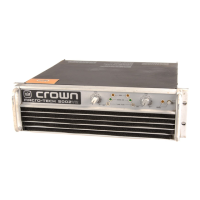

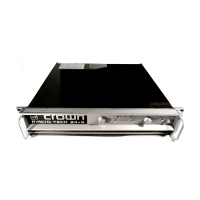

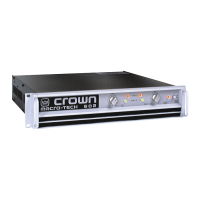
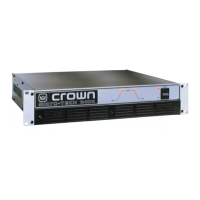
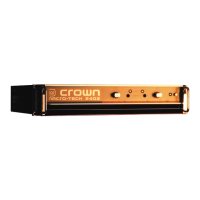
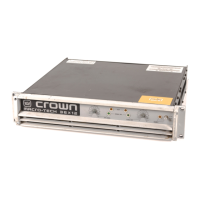
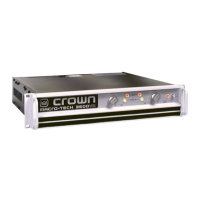
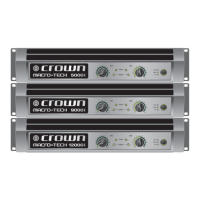
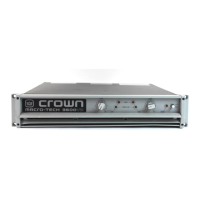
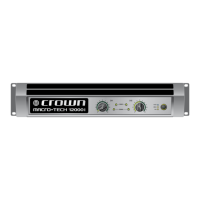
